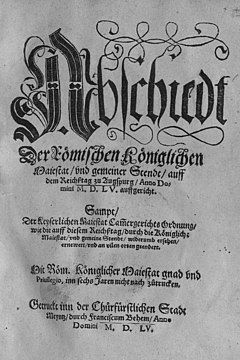
Back Augsburger Reichs- und Religionsfrieden ALS صلح أوغسبورغ Arabic Аугсбургски мир Bulgarian Pau d'Augsburg Catalan Augšpurský mír Czech Den augsburgske religionsfred Danish Augsburger Reichs- und Religionsfrieden German Pêameyışê Augsburgi DIQ Ειρήνη του Άουγκσμπουργκ Greek Paco de Aŭgsburgo Esperanto
This article needs additional citations for verification. (September 2020) |
 The front page of the document. Mainz, 1555. | |
| Date | 1555 |
|---|---|
| Location | Augsburg |
| Participants | Charles V, Schmalkaldic League |
| Outcome | (1) Established the principle Cuius regio, eius religio. (2) Established the principle of reservatum ecclesiasticum. (3) Laid the legal groundwork for two co-existing religious confessions (Catholicism and Lutheranism) in the German-speaking states of the Holy Roman Empire. |
The Peace of Augsburg (German: Augsburger Frieden), also called the Augsburg Settlement,[1] was a treaty between Charles V, Holy Roman Emperor, and the Schmalkaldic League, signed on 25 September 1555 in the German city of Augsburg. It officially ended the religious struggle between the two groups and made the legal division of Christianity permanent within the Holy Roman Empire, allowing rulers to choose either Lutheranism or Roman Catholicism as the official confession of their state. Calvinism was not allowed until the Peace of Westphalia.
The Peace of Augsburg has been described as "the first step on the road toward a European system of sovereign states."[2] The system, created on the basis of the Augsburg Peace, collapsed at the beginning of the 17th century, which was one of the reasons for the Thirty Years' War.
- ^ Hughes, Michael (1992). Early Modern Germany, 1477–1804, MacMillan Press and University of Pennsylvania Press, Philadelphia, p. 59. ISBN 0-8122-1427-7.
- ^ Reus-Smit, Christian (2011). "Struggles for Individual Rights and the Expansion of the International System". International Organization. 65 (2): 207–242. doi:10.1017/S0020818311000038. ISSN 1531-5088. S2CID 145668420.